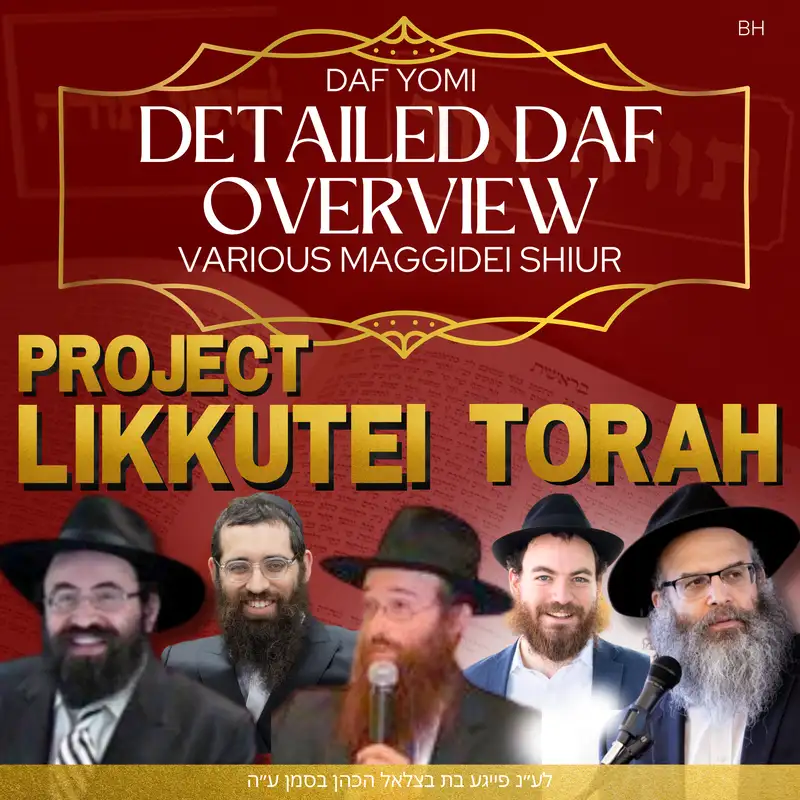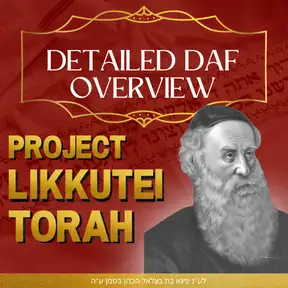
Torah Ohr Daf 62 - From Sea to Dry Land with Rabbi Dovid Leib Shmerling
Summary
“Vayiru ha’am es Hashem v’yaaminu b’Hashem uviMoshe avdo”.Q: why does fear precede faith?There are two manifestations of Hashem that are referred to by the name Havayeh. Havayeh d’Lisatah= Miamleh Kol Almin= Alma d’Isgalya= the way Hashem invests Himself into creation=nature= land.Havayeh d’Lieilah= Sovev Kol Almin= Ratzon= Alma d’Iskasya= the way Hashem is beyond creation= miracles=water. This is the level that Paroh did not believe in, which the plagues came to rectify. In our Avoda, this means that in order to recognize the aspect of Hashem that is beyond nature, we need to have bittul, Sur MeRah, and also positive action, Vaaseh Tov.Kris Yam Suf= the recognition that Hashem is really beyond nature (hafach yam layabasha). We are able to know, and therefore fear the Lower Havayeh. But through Moshe (raya mehemna) we can access our faith in the Higher Havayeh, even while living in this world (yichud beis Havayos).These days, there is no Joy, i.e. no knowledge of the levels of Elokus that are not invested in creation, which we can only relate to in a way of Emunah. However, when Moshiach comes, we will experience these higher levels in a direct, experiential way (ayin b’ayin). After the experience of KRias Yam Suf, the BN”Y didn’t want to leave, i.e. didn’t want to return to the world. Moshe forced them to do so, so they could do the avodah bottom-up (masaos, Seforas Haomer) to be able to receive the Torah.Two types of Havayeh.Moshe= Rayah Mehemnah.Moshiach= from Faith to direct experience. “Az yashir Moshe….. vayomru: ashirah l’Hashem ki ga’o ga’a, sus v’rochvo rama bayam”Q: What’s the inner meaning of Krias Yam Suf? Galus/Geulas Mitzrayim exists for every person, and basically means that we come to have an understanding and appreciation of Hashem through davening. There are two main modes in which Hashem relates to the world: Sovev and Mimaleh, or ALDIS”K and ALDIS”G. The former is the way Hashem is beyond our world and is the reality of Bittul. The latter is the way Hashem is invested in this world, and is the reality of Yeshus.There are two modes of Davening/connecting this world to Elokus:The way of the Kohen, who draws down Elokus into this world (from ALDIS”K to ALDIS”G) through the Brachos of Shemoneh Esreh. This was the Avodah of Moshe, who drew Elokus into this world (ALDIS”G) from his position of ALDIS”K. (Although it seems Moshe has aspects of both kinds of Avodah, see below.)The way of the Levi, who ascends above this world and even above Sovev Kol Almin, through his deep ecstasy, achieved through Pesukei Dezimrah. This can be compared to the ecstasy achieved through music: one is beyond the level of analyzing the music; one loses themselves entirely. This is the level of Reusah Delibah, which reaches Hashem Himself and is therefore beyond reason. This is the meaning of “ashirah laHashem ki ga’o ga’a”, i.e. one connects through “song” to the level of Hashem that is beyond the “beyond”. Galus/Geulas Mitzrayim is not only a historical reality, but a spiritual reality in every person.The Avodah of the Kohen and the Levi.The paradox of language (Osios): they reveal as they conceal, and vice versa. (Gilui=Tzimtzum). Support the show- “Vayiru ha’am es Hashem v’yaaminu b’Hashem uviMoshe avdo”.
Q: why does fear precede faith?
- There are two manifestations of Hashem that are referred to by the name Havayeh.
- Havayeh d’Lisatah= Miamleh Kol Almin= Alma d’Isgalya= the way Hashem invests Himself into creation=nature= land.
- Havayeh d’Lieilah= Sovev Kol Almin= Ratzon= Alma d’Iskasya= the way Hashem is beyond creation= miracles=water. This is the level that Paroh did not believe in, which the plagues came to rectify. In our Avoda, this means that in order to recognize the aspect of Hashem that is beyond nature, we need to have bittul, Sur MeRah, and also positive action, Vaaseh Tov.
- Kris Yam Suf= the recognition that Hashem is really beyond nature (hafach yam layabasha). We are able to know, and therefore fear the Lower Havayeh. But through Moshe (raya mehemna) we can access our faith in the Higher Havayeh, even while living in this world (yichud beis Havayos).
- These days, there is no Joy, i.e. no knowledge of the levels of Elokus that are not invested in creation, which we can only relate to in a way of Emunah. However, when Moshiach comes, we will experience these higher levels in a direct, experiential way (ayin b’ayin).
- After the experience of KRias Yam Suf, the BN”Y didn’t want to leave, i.e. didn’t want to return to the world. Moshe forced them to do so, so they could do the avodah bottom-up (masaos, Seforas Haomer) to be able to receive the Torah.
- Two types of Havayeh.
- Moshe= Rayah Mehemnah.
- Moshiach= from Faith to direct experience.
- “Az yashir Moshe….. vayomru: ashirah l’Hashem ki ga’o ga’a, sus v’rochvo rama bayam”
Q: What’s the inner meaning of Krias Yam Suf?
- Galus/Geulas Mitzrayim exists for every person, and basically means that we come to have an understanding and appreciation of Hashem through davening.
- There are two main modes in which Hashem relates to the world: Sovev and Mimaleh, or ALDIS”K and ALDIS”G. The former is the way Hashem is beyond our world and is the reality of Bittul. The latter is the way Hashem is invested in this world, and is the reality of Yeshus.
- There are two modes of Davening/connecting this world to Elokus:
- The way of the Kohen, who draws down Elokus into this world (from ALDIS”K to ALDIS”G) through the Brachos of Shemoneh Esreh. This was the Avodah of Moshe, who drew Elokus into this world (ALDIS”G) from his position of ALDIS”K. (Although it seems Moshe has aspects of both kinds of Avodah, see below.)
- The way of the Levi, who ascends above this world and even above Sovev Kol Almin, through his deep ecstasy, achieved through Pesukei Dezimrah. This can be compared to the ecstasy achieved through music: one is beyond the level of analyzing the music; one loses themselves entirely. This is the level of Reusah Delibah, which reaches Hashem Himself and is therefore beyond reason. This is the meaning of “ashirah laHashem ki ga’o ga’a”, i.e. one connects through “song” to the level of Hashem that is beyond the “beyond”.
- Galus/Geulas Mitzrayim is not only a historical reality, but a spiritual reality in every person.
- The Avodah of the Kohen and the Levi.
- The paradox of language (Osios): they reveal as they conceal, and vice versa. (Gilui=Tzimtzum).
